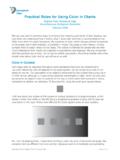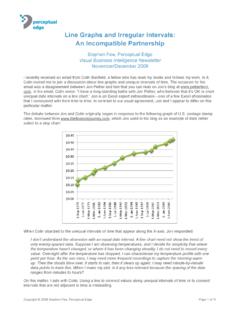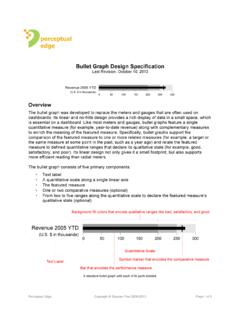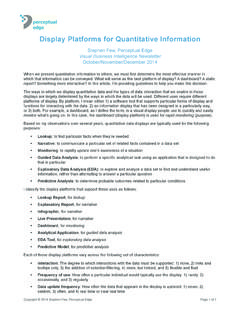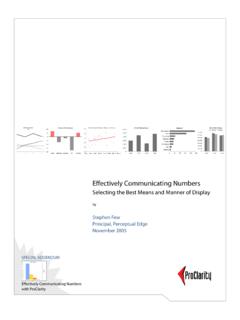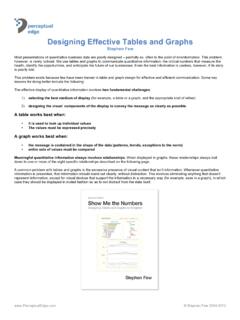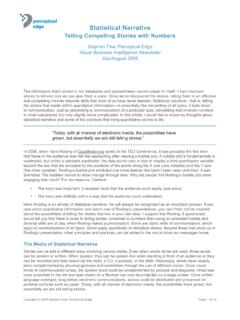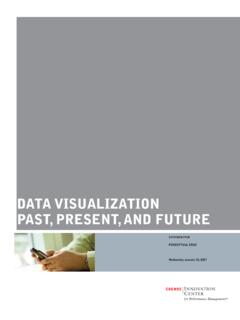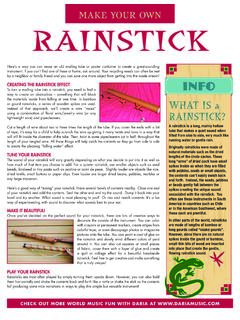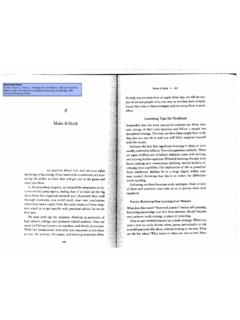Transcription of much more than being about graphics, the visual …
1 Perceptual Edge Sticky Stories Told with Numbers Page 1 Sticky Stories Told with Numbers A review of made to stick by Chip Heath and Dan Heath, two extraordinary communicators Stephen Few visual Business Intelligence Newsletter February 2007 While examining the data, Cheryl discovers a large Hispanic population living within an easy drive to her company s East Bay store, which could be tapped as a significant consumer base. Not only are the products ideally suited for this community, these folks could save a great deal of money by purchasing them from Cheryl s company. The executive steering committee will be meeting in three days, so Cheryl reserves a 15 minute slot on the agenda and gets to work.
2 She spends every minute of those three days preparing her presentation. She has read several books about data presentation, so she is not a novice. She knows how to communicate her findings accurately and clearly. When the time arrives, she delivers the presentation flawlessly, leading the executives through a series of charts that outlines the facts. At the end of her allotted time, she is thanked and dismissed. She then waits. Days pass and to her dismay, the matter is never again mentioned. So much for working hard and actually caring about doing a good job what a waste! Convinced that she has done everything right, andt that the executives either didn t care or are too dense to see the obvious, she never again takes her ideas to the steering committee.
3 I invented Cheryl s story to introduce an important truth about effective communication. Even though this particular scenario is a product of my imagination, you might find it all too familiar. Even a perfectly designed presentation can fail to communicate. It can be delivered flawlessly, but if people listen without sensing its importance, without caring, or without remembering the essential points, it fails. Ultimately, It s All about Communication It is important to remind ourselves from time to time that, much more than being about graphics, the visual displays that we create to present information are essentially about communication. Graphics describe the mode of communication visual in this case but communication is the essence and purpose of the activity.
4 Much more than being about graphics, the visual displays that we create to present information are essentially about communication. Perceptual Edge Sticky Stories Told with Numbers Page 2 Despite what I m known for professionally, I don t see myself primarily as a graphic or information designer, but as a communicator and a teacher. I don t focus on data visualization because of any natural talent or interest in graphics. I focus on it because, as someone who works to help people make sense of quantitative information and present what they ve found to others, I ve been convinced by overwhelming evidence that visual means are often the best. I try to read everything that s written about data visualization, but I spend just as much time reading about communication, education, analysis, decision making, critical thinking, perception, and the workings of the human brain.
5 These areas of study merge to form an interdisciplinary whole that is more enlightening than any of its parts. Every once in a while I find a book that so profoundly explains something about one of these subjects, I feel compelled to tell you about it. made to stick by Chip Heath and Dan Heath is one such book. It reveals a set of truths about effective communication that will seem like common sense once you ve read them, but are not necessarily intuitive until you do. This book doesn t deal with graphical communication at all at least not specifically but the lessons it teaches about crafting messages to make them not only understandable but also compelling and memorable, are essential to the work that we do Chip Heath is a professor of organizational behavior in the Graduate School of Business at Stanford University.
6 His brother Dan Heath is a consultant at Duke Corporate Education and a co-founder of Thinkwell, a textbook company. A few years ago Chip and Dan realized that they were both working on the same problem, but from different angles: How can we make ideas stick ? They were trying to answer two important questions: Why do some ideas thrive while others die? And how do we improve the chances of worthy ideas? Some ideas, such as urban legends, proverbs, and well-crafted advertisements have a sticky quality. They get into our heads and remain there. Most business communication, however, is instantly forgotten, and often isn t comprehensible or worth remembering anyway.
7 If you have something important to say, how can you make your message stick ? The brothers Heath have recognized a problem that has long concerned me as well: There is a curious disconnect between the amount of time we invest in training people how to arrive at an Answer and the amount of time we invest in training them how to Tell Others. It s easy to graduate from medical school or an MBA program without ever taking a class in communication. College professors take dozens of courses in their areas of expertise but none on how to Business managers seem to believe that, once they ve clicked through a PowerPoint presentation showcasing their conclusions, they ve successfully communicated their ideas.
8 What they ve done is share data. If they re good speakers, they may even have created an enhanced sense, among their employees and peers, that they are decisive or managerial or motivational ..Surprise will come when they realize that nothing they ve said had impact. They ve shared data, but they haven t created ideas that are useful and lasting. Nothing stuck. (pages 245 and 246) The ability to communicate is essential to the work of all professionals more so than almost anything else but the need for training in the area remains largely ignored and is seldom even recognized. Poor communication is the cause of incalculable harm, both in our personal Perceptual Edge Sticky Stories Told with Numbers Page 3 and professional lives.
9 The harm it does to business, which definitely affects the bottom line, is the stuff of tragicomedy. Most could be avoided, but the characters continue to stumble around the stage from one mistake to another, completely unaware. No one, however, is laughing. Sticky Guidelines made to stick devotes most of its pages to practical answers to the particular communication challenge it addresses: to make good ideas heard, understood, and remembered, and to provide guidance for how to respond. I won t give in to the temptation to share too much of the excellent advice that this book offers, because I don t want you to think that the glimpse that I provide is a substitute for reading the book yourselves.
10 You need to get a copy of your own and keep it handy. I will say enough, however, to demonstrate this book s worth and to wet your appetite for more. Here are the book s lessons in a nutshell. Ideas that stick exhibit the following six characteristics: 1. Simplicity 2. Unexpectedness 3. Concreteness 4. Credibility 5. Emotions 6. Stories Now, to put a bit of meat on these bones, here are a few excerpts from the book that describe these characteristics. Simplicity What we mean by simple is finding the core of the idea. Finding the core means stripping and idea down to it most critical s about discarding a lot of great insights in order to let the most important insight more we reduce the amount of information in an idea, the stickier it will be.
